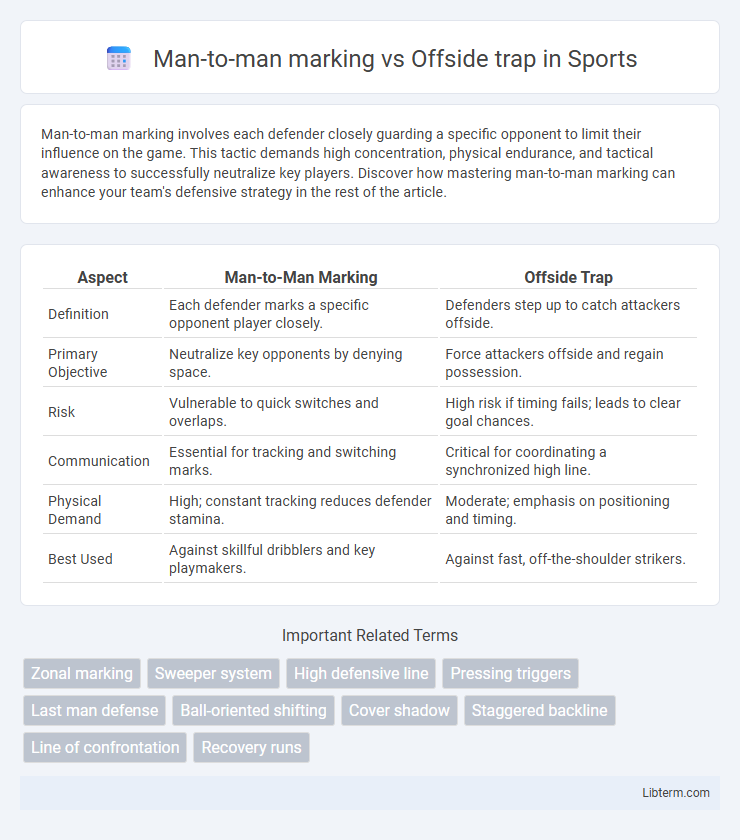Man-to-man marking involves each defender closely guarding a specific opponent to limit their influence on the game. This tactic demands high concentration, physical endurance, and tactical awareness to successfully neutralize key players. Discover how mastering man-to-man marking can enhance your team's defensive strategy in the rest of the article.
Table of Comparison
| Aspect | Man-to-Man Marking | Offside Trap |
|---|---|---|
| Definition | Each defender marks a specific opponent player closely. | Defenders step up to catch attackers offside. |
| Primary Objective | Neutralize key opponents by denying space. | Force attackers offside and regain possession. |
| Risk | Vulnerable to quick switches and overlaps. | High risk if timing fails; leads to clear goal chances. |
| Communication | Essential for tracking and switching marks. | Critical for coordinating a synchronized high line. |
| Physical Demand | High; constant tracking reduces defender stamina. | Moderate; emphasis on positioning and timing. |
| Best Used | Against skillful dribblers and key playmakers. | Against fast, off-the-shoulder strikers. |
Introduction to Defensive Strategies in Football
Man-to-man marking and the offside trap are fundamental defensive strategies in football designed to disrupt the opposition's attacking flow. Man-to-man marking involves assigning a defender to closely follow a specific opponent, limiting their space and reducing passing options. The offside trap, coordinated among defenders, aims to catch attackers offside by moving the defensive line forward at the precise moment the ball is played, requiring impeccable timing and communication.
Understanding Man-to-Man Marking
Man-to-man marking assigns each defender to closely track a specific opponent, limiting their movement and disrupting attacking plays. This defensive strategy requires strong individual awareness, physicality, and anticipation to prevent key players from receiving the ball or creating chances. Effective man-to-man marking relies on communication and positioning to maintain tight coverage throughout the match.
The Mechanics of the Offside Trap
The mechanics of the offside trap rely on coordinated positioning and timing among defenders to catch opposing attackers offside by stepping upfield just before a pass is played. This technique requires precise communication and awareness of the opponent's forward runs to maintain a high defensive line effectively. Successful execution disrupts opposition attacks by limiting their space behind the defense and forcing turnovers.
Key Differences Between Man-to-Man Marking and Offside Trap
Man-to-man marking assigns each defender to closely guard a specific opponent, ensuring tight control and reducing individual player freedom. The offside trap relies on coordinated defensive line movement to catch attacking players offside, emphasizing timing and spatial awareness over direct opponent engagement. Man-to-man marking focuses on direct pressure and interception, while the offside trap exploits positioning and team coordination to disrupt offensive plays.
Strengths of Man-to-Man Marking
Man-to-man marking excels in neutralizing key opponents by assigning defenders to shadow specific attackers, minimizing their impact on the game. This approach offers precise coverage, reducing space for dribbling and short passes within tight defensive lines. It enhances defensive accountability and coordination, making it harder for opponents to exploit individual mismatches or create clear goal-scoring opportunities.
Advantages of Using the Offside Trap
The offside trap effectively disrupts the attacking flow by forcing opponents into offside positions, reducing their scoring opportunities and increasing defensive control. This tactic enhances team coordination and spatial awareness, enabling defenders to maintain a compact line and minimize gaps exploited by attackers. Utilizing the offside trap can conserve energy and concentrate defensive efforts, often leading to turnovers and counterattack chances.
Weaknesses and Risks of Man-to-Man Marking
Man-to-man marking exposes defensive vulnerabilities by overstretching players, leading to increased susceptibility against fast attackers exploiting space. It demands high stamina and concentration, where a single lapse can result in losing the opponent and conceding goals. Unlike the offside trap which relies on synchronization, man-to-man marking risks isolation and mismatches, especially against skillful, agile forwards.
Common Challenges with the Offside Trap
The offside trap in soccer often faces challenges such as precise timing and coordination among defenders to maintain a unified defensive line. Miscommunication or hesitation can easily result in opponents breaking through the line, rendering the trap ineffective and exposing defenders to one-on-one situations. In contrast, man-to-man marking focuses on individual defensive assignments, reducing reliance on collective positioning but requiring constant awareness and physical endurance to track specific attackers.
Tactical Suitability: When to Use Each System
Man-to-man marking proves tactically suitable against teams that rely on specific key players for attack, allowing defenders to neutralize threats by closely following opponents' movements. The offside trap is effective for teams with a disciplined and well-coordinated defensive line, aiming to catch attackers offside and disrupt fast-paced, through-ball strategies. Coaches often choose man-to-man marking in tight matches requiring intense pressure, while the offside trap excels in controlling space and maintaining high defensive lines against teams with less mobility.
Modern Trends: Combining Defensive Techniques
Modern defensive strategies in football increasingly blend man-to-man marking with the offside trap to enhance team cohesion and disrupt opposing attacks. This hybrid approach leverages man-to-man marking's close player tracking while utilizing the offside trap's spatial control to orchestrate high defensive lines and quick recovery. Tactical integration of these methods demands advanced communication and situational awareness, reflecting a shift towards dynamic, adaptive defensive systems in contemporary football.
Man-to-man marking Infographic

 libterm.com
libterm.com